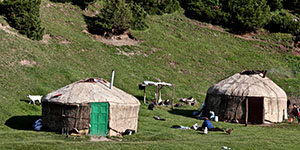
Grassy steppes, scorching deserts, perilous mountain ranges, and fertile valleys comprise the richly varied physical geography of Central Asia. Today, it is composed of five countries, all of which were republics of the former Soviet Union: Kazakhstan, Kyrgyzstan, Tajikistan, Turkmenistan, and Uzbekistan. The region's history extends far back before the influence of Russia, however, which only began in the nineteenth century. This is the ancient land of Silk Road caravans, oasis kingdoms, dynasties, and khanates. Various nomadic groups predominated for most of the last four to five millennia, with horse riding people such as the Huns, the Scythians and perhaps most famously, the Mongols (under Genghis Khan’s leadership) ruling large portions of the area.
Each of the Central Asian nations is named for the ethnic group that dominates there. The Kyrgyz live in the mountainous regions of Tien Shan and Pamir-Alai, while the Tajiks occupy the territory to the south of Kyrgyzstan and comprise large communities in the Uzbek cities of Bukhara and Samarkand. In the far west of Uzbekistan, situated on the Aral Sea, is the autonomous Republic of Karakalpakstan. To the south lies Turkmenistan, bordering Afghanistan and Iran, home to both sedentary and semi-nomadic peoples. There is a great deal of overlap among all of these groups, however; for instance, many Uzbeks live in Tajikistan and vice versa (15-20% of Uzbekistan's population is ethnically Tajik, which is about the same percentage of Uzbeks in Tajikistan). In the arid, open spaces of this part of the world, people have always intermingled, sometimes coming into conflict with one another, but also sharing cultural practices and forms of material culture.
Landscape, language, and cultural traditions provide enormous diversity, yet there is also a commonality provided by cross-cultural fertilization, evident in the vibrant quilts and patchwork of Central Asia. The merging of motif and meaning, developed over centuries, contributes a fundamental life-force to this living tradition.